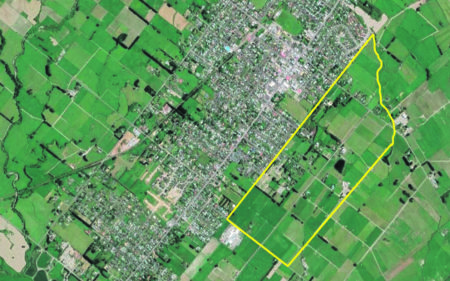Background 
Carterton needs to plan for where to accommodate the increasing Carterton population, new housing and businesses.
It is projected the urban area of Carterton will need to accommodate approximately 1,000 new houses between now and 2043.
Our Growth Strategy, published in 2017, identified the eastern side of the Carterton urban area as the most suitable location and direction for new greenfield development.
This was due to its proximity and accessibility to existing community and infrastructure facilities and services.
In December 2020/January 2021, the council released a proposed CDC Structure Plan for public consultation. It included four options which we sought public feedback on.
At the August Policy and Strategy committee meeting, the elected members discussed the proposed options for the draft Eastern Growth Plan we consulted on earlier in the year.
The proposed next steps included an investigation into water supply possibilities for growth, including sustainability and resilience factors for the future of the Carterton Urban water supply.
Here’s a video of the meeting [the discussion starting at 12mins 10 seconds]:
What has happened since the consultation closed?
As mentioned above, the Council’s Policy and Strategy committee discussed the next steps at its 7 April and 4 August meetings. These can be found at:
Policy and Strategy Committee, 7 April
Policy and Strategy Committee, 4 August
Which option was recommended?
Based on the feedback, Council officers recommended option 4, providing for the smaller lots people requested but requiring an average lot size to be met across a development this has the impact of reducing lot sizes to 1,074 lots across the area.
Please also note that to manage the growth the area has been divided into three stages providing for high density lots on the western side of Rutland Road, while supporting a minimum 2000m2 lots on the Eastern side of Rutland at each stage, this provides a buffer between the high density and the rural outlook.
In this option for stage 1a and 2a the recommendation is to have a 400m2 average, while in stage 3a providing for a minimum of 400m2with an average of 600m2.
What has been decided and will people get another chance to give feedback?
At this stage, the plan isn’t finalised.
The Policy and Strategy Committee recommended that Council instruct staff to engage a suitable consultant to investigate water supply possibilities for growth, as per option 4 , including sustainability and resilience factors for the future of the Carterton urban water supply.
Elected members also wanted some smaller lots on Rutland Road, so the plan is being revised to provide for some 1000m2 lots with a 1500m2 average in this area.
Until this work is undertaken officers are not recommending further consultation or proceeding with a formal plan change.
Why have the number of lots and lot sizes changed?
The option that went out for consultation (462 units) was option 1.
The feedback received indicated that this option was not what the community wanted in terms of density as it did not provide for the smaller size lots.
Will there be any kind of housing provision set aside for people already living in Carterton?
Successfully implementing the Plan will in turn allow Council to work on the Carterton District Housing Action Plan.
The vision of this plan is that Carterton has a diverse range of quality housing options to meet the needs of current and future communities.
The District will achieve these by stimulate housing supply by providing developable land; providing rates remissions for papakāinga housing; and consolidating relationships with some housing stakeholders.
Council will also enable development through regulatory settings such as updating residential rules in the District Plan to enable a wider range of density options; considering the use of inclusionary zoning; and extending the Urban Growth Strategy beyond Carterton East.
Finally, Council will act as an intermediary for development by forming strong relationships with landowners, developers, and other stakeholders.
We will also communicate development opportunities to the private sector to enable pipeline delivery planning, and monitor housing indicators to inform supply responses.
How will the new houses be provided with water without negatively impacting existing residents and the environment?
Water supply networks will be expanded into the new development areas.
As noted above, investigation of water supply possibilities for growth, including the sustainability and resilience factors for the future of the Carterton Urban water supply, are part of the District Council’s 10-year-plan.
Other measures to accommodate growth include:
- investigating the impact of proposed consent conditions on Carterton in the summer period, but at a reduced minimum stream flow of 83 L/s, and measure effects on downstream ecology. Refine draft conditions following those investigations.
- reviewing CDC revenue and financing policy to reduce pricing elasticity through more effective use of universal metering to increase relationship between water use and price.
- promoting greater water use of water conservation measures to offset unnecessary consumption and reduce costs to users.
- investigating alternative storage and supply option.
- adding filtration to the supplementary groundwater supply to enable the use of existing bores.
- increasing treated water storage to three days’ supply by 2024.
- constructing a supplementary supply, or 200,000m3 raw water storage.
What is the Council doing in relation to planning for growth in schools and an increased demand on the medical centre?
Should council decide to proceed with a plan change then stakeholder engagement will occur and schools and service providers would be part of this group. We have sought feedback over the last couple of years and have not to date received any feedback from the Ministry of Education or the Ministry of Health, but we would welcome this discussion with either organisation or individual schools or other service providers should they wish to engage with us. The Eastern Growth Plan area does have some additional zoning for businesses to support the growth on the eastern side along with areas designated as a business hub/light industrial. We also recognise that some of the feedback received from individuals has noted the potential increase in demand for schools/medical centres etc and we are cognisant of the need to encourage and support these in order to provide for future growth.
A new facility in Greytown, Five Rivers, will help address Wairarapa’s need for more medical care in the short term.
What about new trunk roads?
New roading will be developed if the plan change gets adopted.
What about the sale of the parcel of land between Chester and Belvedere Roads?
The only significant land Council owns between Chester and Belvedere is Howard Booth Park, no discussions have been had regarding the sale of this land.
What are the next steps?
Engage a suitable consultant to investigate water supply possibilities for growth as per option 4 including sustainability and resilience factors for the future of the Carterton Urban water supply.
Officers are not recommending further consultation or proceeding with a formal plan change until the water supply investigation happens.
Once the investigation is complete, officers can undertake further consultation with the community, or move straight to a formal plan change process.
The formal plan change process has a number of statutory bodies that are required to be consulted under Schedule 1 of the Resource Management Act 1991 (RMA) when developing a plan change.
The following is a list of parties that councils must consult with in preparing a proposed plan change:
- • the Minister for the Environment, and;
• those other Ministers of the Crown who may be affected by the policy statement or plan, and;
• local authorities who may also be affected, and;
• the tāngata whenua of the area who may be so affected, through iwi authorities, and;
• any customary marine title group in the area.
A plan change cannot be notified for public consultation till the Schedule 1 consultation has been undertaken.
Once the Schedule 1 consultation is complete, a further decision by the Council will be required to adopt and notify the Proposed Plan Change for formal consultation with the community as set out in the RMA.
The formal consultation provides for a hearing where submitters can speak to their submission.
How can I stay up to date on any further updates?
Sign up for updates straight to your inbox here


